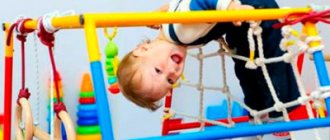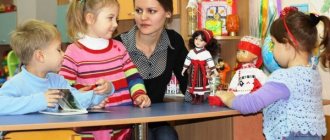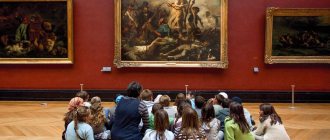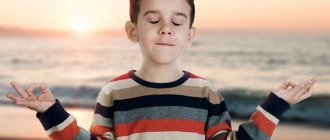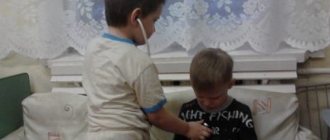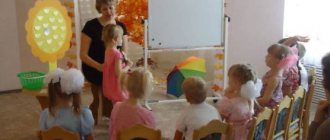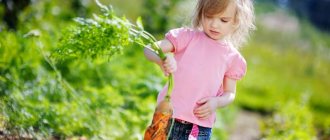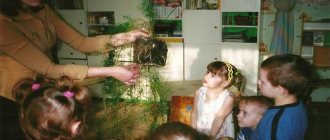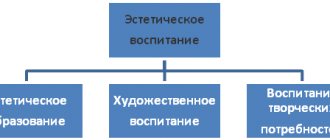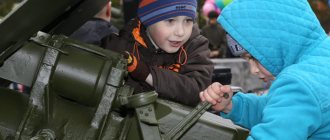Modern view on physical education of preschool children
A variety of medical, sociological, demographic and other data reflecting the dynamics of the condition of Russian children in recent years indicate that the so-called humanitarian catastrophe is no longer an alarming prospect that looms somewhere in an uncertain tomorrow, but the harsh reality of our days.
Until now, the psychological and pedagogical mechanisms of motivation for the perception of physical culture as a factor in the overall harmonious development of the individual have not been sufficiently revealed; the structural elements of children’s conscious attitude towards physical education, sports and a healthy lifestyle have not been clarified; practical pedagogy, theory and methodology of physical education, sports training requires scientific substantiation of the structural components of positive motivation and methods of its formation in children in physical education classes.
The time has come when it is necessary to combine knowledge, traditions, various techniques and put them at the service of human health. Considering health as the main resource for everyday life and a significant indicator of a person’s quality of life, it is necessary to recognize that, in accordance with the principles of state policy in the field of education (priority of human life and health), maintaining and strengthening the health of children is the most important condition and goal of upbringing and education.
Preschool age is one of the most crucial periods in the life of every person. It is at this age that the foundations of health and proper physical development are laid, motor abilities are formed, interest in physical culture and sports is formed, personal, moral-volitional and behavioral qualities are cultivated.
It is believed that a child acquires about 80% of knowledge and skills in preschool age, attending kindergarten, and another 10% each at school and subsequent life. This also applies to the health of children; only with proper physical activity, proper nutrition, and compliance with hygiene standards can the health of the younger generation be preserved. Therefore, it is to children of preschool age that special attention should be paid to both specialists working with them and their parents.
Experienced physical education specialists should work with children of preschool age in order to conduct constant and targeted work to preserve and strengthen their health, improve their physical qualities, and acquire motor skills and abilities.
Physical education of preschool children, methods of preserving and strengthening their health, should not remain aloof from progressive teaching methods. In order to achieve good results in the physical education of preschool children, instilling healthy lifestyle skills that meet the new demands of society, we need new tools and new teaching technologies built on their basis.
A comprehensive system for raising a preschool child who is physically healthy, diversified, proactive and liberated, with a developed sense of self-esteem, includes several areas: ensuring physical and psychological well-being, protecting and promoting health, and introducing the child to universal human values. The age of the children, the existing conditions and the specific system of action should be taken into account.
This requires high professionalism from physical education specialists and teachers, serious theoretical and methodological training, a humane attitude towards children, and the establishment of a partnership style of communication.
A physical education specialist working with children must be able to:
- organize a group of children in such a way that they are free and independent and at the same time feel cozy and comfortable;
- communicate informally with children, try to live the same life with them, without suppressing their activity, listen to children more, talk less yourself;
- be patient and self-possessed, be fluent in relaxation and proper breathing techniques and be able to help children master them;
- know domestic and foreign methods of health promotion, non-traditional methods of physical and psychological self-improvement;
- have a partnering style of communication with children;
- be able to provide children with the opportunity to see for themselves the problem and ways to solve it;
- be able to anticipate the manifestation of possible negative emotions in children and warn them in time;
- create conditions for the fulfillment of children’s needs for physical activity in everyday life;
- develop the ability to see each child, feel his inner state, respect his individuality;
- identify the interests, inclinations and abilities of children in physical activity and implement them through a system of physical education, health and sports activities;
- promote a healthy lifestyle;
- be able to diagnose the physical fitness and physical development of children.
Physical education of preschool children includes several main sections:
- Diagnosis of physical development.
- Organization of motor activity.
- Therapeutic and preventive work, hardening.
- Planning and organizing physical events.
- Collaboration between kindergartens, parents and doctors to raise a healthy child.
- Fostering the need for a healthy lifestyle.
All employees of preschool institutions (preschool institutions), physical education specialists working in preschool educational institutions, need to rethink work with preschoolers in the field of not only physical education, physical education and physical culture, but also training and education in general, organization of the regime, treatment and preventive work , communication, etc. During the day, it is important to perform physiologically based movements. One of the main points of physical education, in our opinion, is the realization of children’s need for movement through the widespread use of cyclic endurance exercises in the educational process, as the most accessible and effective means of physical training.
Physical education classes should solve the problems of training the cardiovascular and respiratory systems, thermoregulation of the body, and give the desired effect in strengthening the health of each individual. It is necessary to abandon the rigid methodology of conducting physical education classes and their monotony. Physical fitness standards should take into account the level of physical development of children, their state of health, as well as their life experience.
Goals and objectives of preschool educational institutions:
- protection and strengthening of the physical and mental health of children;
- ensuring the physical, intellectual, personal development of the child;
- caring for the emotional well-being of each child;
- interaction with the family to ensure the full development of the child.
As is known, during childhood (3-10 years) a set of measures is carried out aimed at strengthening and preserving physical and mental health, hardening and physical development of children, creating conditions for them to demonstrate creative abilities, and the formation of universal human values.
At the end of childhood, the child must: be developed spiritually and physically, be oriented toward universal human values, and master self-organization techniques. At the same time, the period of childhood is considered as a period of independent value in the lives of children, by the end of which the child acquires:
- a certain age-appropriate level of children's competence;
- communication skills that allow you to interact with adults and peers;
- required level of cognitive abilities;
- arbitrariness of behavior and manifestations of emotional and affective experiences;
- value orientations.
Considering the indisputable fact that a child lives his childhood, and adults organize this process, physical education workers must pursue several goals :
- creating conditions conducive to the formation of a physically developed and psychologically healthy child’s personality;
- realization of creative possibilities within the limits of one’s competence, i.e. psychological and pedagogical conditions for raising and teaching children;
- active involvement of parents and additional education teachers in the process of raising and educating children.
Each of the identified goals is specified through the corresponding tasks:
- Creation of psychological and pedagogical conditions for education and training:
- organization of a developmental environment in the group;
- taking into account the individual characteristics of the child’s development and the characteristics of the children’s group;
- providing socio-psychological support for the child;
- predicting the child’s development process;
- implementation of development programs;
- carrying out corrective and adaptive procedures.
- Active involvement of parents and additional education teachers in the process of physical education:
- formation in parents of a conscious attitude towards the goals and objectives of raising children;
- inclusion of parents and additional education teachers in activities aimed at creating conditions conducive to the development of children;
- formation of a positive attitude among parents towards mastering the knowledge of psychology and pedagogy, the basics of medicine and valeology.
The activities of educational institutions during childhood include two processes: educational and educational and educational and health-improving.
The concept of “educational and health work” seems broader than the concept of “physical education,” which often refers only to the development of motor skills.
The main sections of educational and health work of educational institutions during childhood are:
- organization of a rational motor mode for children;
- implementation of an effective hardening system, the use of psychological means and methods;
- providing adequate nutrition and creating conditions for organizational and health regimes for children.
The necessary introductory section from which educational and health work begins is diagnostics, i.e. a set of tests, including the determination of initial indicators of physical development, motor readiness, objective and subjective health criteria, etc.
Only by implementing such an integrated approach can one achieve the fulfillment of the main objectives of educational and health work to strengthen the physical and mental health of children, their optimal physical development and motor readiness.
When working with children, one should follow the principles of rational organization of physical activity, including physical education training sessions:
- the predominance of cyclic exercises in all types of physical activity of children to train and improve general endurance (long running, cross-country running, hiking, etc.);
- daily physical education, mainly outdoors;
- frequent change of exercises with multiple (10-12 times) repetition of one exercise;
- conducting most physical education classes in a playful way;
- motor density of physical education classes – 80% or more;
- compulsory musical accompaniment of physical education classes;
- children’s conscious attitude towards doing exercises;
- muscle relaxation, proper breathing are necessary components of physical education classes;
- the predominance of positive emotions in all types of motor activity of children during childhood;
- Particular attention should be paid to safety precautions in physical education classes. Physical activity must be adequate to the physical and mental state of the child in this lesson.
It is necessary to observe the basic principles of physical education :
- the principle of developmental education - the proposed exercises should not be aimed at the level of qualities currently available in children, but ahead of it, requiring the application of effort to master new movements;
- the principle of educational training - work aimed at developing motor qualities must necessarily include the solution of educational tasks, for example, nurturing perseverance, courage, endurance, etc.;
- the principle of comprehensiveness – ensuring high manifestation of qualities in various types of motor activity, ensuring a general increase in the functional capabilities of the body;
- the principle of systematicity - consistent complication of content, connection of new things with what has already been learned, increasing requirements for the level of qualities as they develop;
- the principle of consciousness and activity of children - the conscious attitude of children to the proposed exercises increases their assimilation, fosters independence and initiative;
- the principle of an individual approach is based on taking into account the different levels of motor qualities that children have and requires a differentiated attitude and flexibility in the selection of motor tasks.
To preserve and strengthen the health of children, it is very important to carry out hardening procedures and at the same time follow the principles of implementing an effective hardening system:
- clothing (outdoor and indoor) appropriate for the weather. Clothes made from synthetic fabrics should be avoided;
- Conducting physical education classes barefoot is an effective hardening agent, provided that it is gradually introduced;
- The leading scientifically based methods of hardening are contrast baths and showers. It is these methods that contribute to the development and improvement of the physical thermoregulation system, which functions poorly in the first years of a child’s life;
- cyclic exercises performed by children in loose clothing that does not restrict movement during classes (especially outdoors) and walks have a good hardening and healing effect;
- excellent hardening results can be obtained in a health complex, including a swimming pool, sauna, herbal bar, hot and cold rubdowns, etc.
of great importance in working with preschool children:
- identification of factors contributing to the emergence and development of stressful and neurotic conditions in children;
- the use of psychological and pedagogical techniques aimed at relieving and preventing unwanted affective manifestations;
- providing conditions for the predominance of positive emotions in the daily routine of each child;
- creating a favorable psychological climate in an educational institution;
- teaching children muscle relaxation techniques - a basic condition for mental and physical self-improvement;
- organization of a psychological relief room in an educational institution and, if possible, a corner of wildlife in each group.
The use of psychoanalytic and personality-oriented conversations with children with affective and neurotic manifestations;
- rational use of “music therapy”, “color therapy” to normalize the emotional state of children.
Attention should be paid to the principles of implementing health regimes:
- organizing a regime for children in accordance with the characteristics of the individual biorhythmological profile, the main components of which are physical education and mental work, as well as emotional reactivity in the daily routine;
- stereotypically repeating routine moments: meal times, daytime and night sleep, the total duration of the child’s stay outdoors and indoors (if in a preschool institution these moments are generally observed, then at home they often require adjustment). The remaining components of the mode are dynamic.
The preservation and development of a child’s health as a pedagogical task can be solved if the teacher’s activities are based on the practical application of knowledge of the psychophysiological laws of human development and are aimed at creating conditions for the physical, spiritual and intellectual development of the child.
In this regard, there is a need to update the professional responsibility of teachers and heads of educational bodies and institutions for organizing the educational process in accordance with the requirements:
- taking into account the individual (intellectual, emotional, motivational and other) characteristics of the child, his temperament, the nature of his perception of educational material, etc.;
- refusal of excessive, debilitating intellectual and emotional stress when mastering educational material;
- ensuring a favorable moral and psychological climate in the team, unconditionally preserving, maintaining and strengthening the mental health of children, eliminating any factors that may negatively affect the mental state of the child (authoritarian pressure, rudeness, caustic offensive irony, tactlessness, lack of conditions to meet the basic needs of the student in self-expression, security, good attitude towards friends, etc.).
The educational process can be considered as a way of life that a developing person leads for many years before gaining (or finally losing, which, unfortunately, happens) independence, autonomy, social and personal responsibility - the ability to independently build a way of life that is best would be suitable for this particular person and at the same time would embody potential human capabilities. The educational process as a way of life, built day by day by teachers, leaders, parents and children, contains enormous developmental or destructive potential, depending on how well it is consistent with universal human needs - the needs for bodily well-being, safety, human relationships, respect, dignity, meaning in daily activities and prospects. Neglect of these universal human needs is the strongest, if not insurmountable, obstacle to obtaining any educational results. Attention to human needs compensates for the lack of many particular conditions and, even with minimal support for the educational process, guarantees results.
General requirements for the physical education of preschool children aged 3-7 years:
- develop an interest in physical education and use it to develop positive character traits and behavior;
- consolidate and expand the fund of basic vital motor skills, skills and physical qualities acquired earlier, teach basic knowledge in the field of physical education;
- to promote an increase in the general level of functional and adaptive capabilities of a growing organism in relation to the characteristics of this stage of ontogenesis;
- ensure the targeted development of physical and psychomotor qualities based on them; carry out hardening of children, taking into account a wide range of influences of various environmental factors, to form a normal physique.
Children should:
- solve motor tasks that are feasible at a given age, using rational methods of motor actions, including walking, running, jumping, climbing, overcoming object obstacles, riding a bicycle, skiing, skating, etc., throwing (at a target and for distance), lifting and carrying objects; overcome fear of the aquatic environment; be able to float on the surface of the water;
- perform accessible gymnastic and dance exercises and consciously interact in outdoor and sports games;
- perform exercises that require coordination of movements, speed and speed-strength qualities, endurance and flexibility at the level of physical fitness indicators normalized for a given age, have normal posture and body weight;
- have basic knowledge in the field of physical education, personal hygiene; have basic self-care skills, learn the rules of safety and care of physical education equipment.
Facilities:
- sets of exercises of basic, hygienic and breathing gymnastics, exercises for the development of physical qualities, outdoor games, dancing, cyclic exercises and other types of physical activity, regulated in relation to age groups of preschool children, sun, air and water baths, hygienic factors, massage.
- volume and mode of physical culture and motor activity: at least three physical culture and recreational classes of various forms daily with a total volume of at least 5-6 hours per week in junior groups, 6-8 hours in middle groups and 8-10 hours in senior groups.
Organization of physical education classes for children 3-7 years old
The following physical education classes are held daily in groups of children from 3 to 7 years old: morning exercises, physical education, exercises after naps. This allows you to create an optimal motor mode. Physical education activities should be carried out mainly in the fresh air.
During physical education classes, children accumulate the necessary experience that is required for other types of activities. An important point for physical education classes is the teacher’s reliance on the child’s life experience.
In order to maintain children’s interest in physical education, it is necessary to conduct classes every day (in accordance with the Law of the Russian Federation “On Physical Culture and Sports”), combining training, educational and entertainment elements in a playful way. This will allow organizing individual and group training in various programs, taking into account the health status and interests of children, without overloading them.
Each physical education lesson should have a different focus depending on age. The main thing for the little ones is to give them as much pleasure as possible, teach them how to navigate the entire space of the site, work correctly with equipment, and teach them basic self-insurance techniques.
In middle age, when organizing classes, the trainer-teacher, physical education instructor or teacher directs the main attention to the development of physical qualities, especially endurance and strength , which will become the basis for the physical training of children.
In older preschool age, much attention should be paid to the physical training of children, the development of their motor abilities and the development of independence. It is recommended to do physical exercise at the end of the walk. 35-40 minutes before it ends, children change into sportswear and go out onto the playground.
The duration of classes should be 20-40 minutes, depending on the nature of the load, the content of the material, the mood of the children, weather conditions, etc. Complex training sessions should be no more than 3 per week.
The rest of the classes, as a rule, are plot-based, complex, with elements of sports entertainment. During them, in addition to consolidating and improving movements, some problems of developing mathematical concepts, speech, acquaintance with the outside world, etc. must be solved.
One of the mandatory components of all classes is the introduction of special recreational activities. Classes can be combined with air baths and water procedures, with elements of breathing exercises, etc. It is necessary to create a special emotional and psychological background, to let children feel interested in their successes.
Options for basic physical education activities:
- Classes of the usual type, examples of which can be found in many methodological developments.
- Game activities based on outdoor games and relay games with the inclusion of attraction games.
- Training sessions.
- Walks and hikes.
- Story-based and game-based activities (this is where it is necessary to solve problems in speech development, getting to know the outside world, etc.).
- Classes at sports complexes and exercise machines.
- Classes based on dance material.
- Independent studies.
- Classes in the series “I know how to control myself” or “Know yourself.”
- Test classes, competitions in various sports (mandatory in the presence of a medical professional).
Planning of physical education and health activities
Complexes of morning exercises are compiled a month in advance in four main options, depending on weather conditions. Each option takes into account the individual characteristics of children during childhood. After a month, new versions of morning exercises are compiled.
Options for physical education activities are also planned a month in advance in order to ensure their variety and correctly distribute the load throughout the week.
The work of sports sections and clubs is also planned for a year and six months in advance.
The teacher and the trainer-teacher coordinate their work and, as a rule, draw up a joint work plan. Some of the classes conducted by the teacher are preparatory to the development of a new motor action, which will be continued by the coach.
The motor experience that children accumulate during childhood with a coach or physical education instructor should then be used by the teacher in various physical education and recreational activities.
Thanks to a stable calendar of competitions and sports events, children have the opportunity to purposefully prepare for specific competitions, and all events are evenly distributed throughout the school year.
Participation in competitions develops children's interest in sports and physical education, accustoms children to a healthy lifestyle, develops physical qualities, and fosters moral and volitional qualities.
Regular participation of children in hikes also develops their physical qualities and brings health benefits. Children get good physical exercise and are emotionally unloaded by relaxing in nature. Forest air has a beneficial effect on children's bodies. In the summer, when visiting the beach or city stadium, children are given the opportunity to walk barefoot on the grass, sand, and pebbles, which helps harden them, prevent flat feet, and is very good for health.
Features of physical education of preschool children
The total amount of independent physical activity under the guidance of adults in kindergarten and family in primary and secondary preschool age should be 9-12 hours per week, in senior age - 12-14 hours, including 2-5 hours at home. It is recommended to conduct daily morning exercises (5-10 minutes depending on the age of the child), 2-3 times a day physical education classes (from 30 minutes for younger, to 45 minutes for older preschoolers).
In addition, targeted training sessions are required under the guidance of a preschool physical education instructor 2-3 times a week, as well as outdoor games during walks (up to 20 minutes) at least 2 times a week.
The main principle is to do physical exercises with children while playing. It is recommended to conduct classes in the form of stories, during which the instructor invites the child to perform a chain of sequential movements, creating a series of familiar images, i.e., explain less to the child and show more. For example, a walk through the zoo, a hike, a trip to the moon, etc. Explanations should be clear, concise, and given in a cheerful, cheerful voice. Don't forget to monitor your baby's breathing. Teach him to breathe through his nose and not stop breathing. It is necessary to pay special attention to breathing, relaxation, and posture - this is the basis for combating fatigue and stress.
When compiling a complex for classes with 3-4 year old children, you should include 2-3 exercises for the arms, 1-2 exercises for the torso, 2-3 exercises for the legs. For children 5-6 years old, the number of exercises in the complex increases by 2-3 times. Almost every lesson must include joint exercises; finger exercises are possible, as well as elements of self-massage.
Physical exercises and various types of entertainment are recommended to be organized mainly in the fresh air. Particular attention should be paid to children's clothing and shoes during classes.
Jumping should occupy a large place in the child’s motor activity (regardless of the specialization of the physical education instructor or the sports direction taught by the trainer-teacher). They help strengthen the musculoskeletal system, develop muscles, and develop coordination of movements. When working with children of this age, you should completely eliminate the load on the spine, give more stretching and relaxation exercises - this is the basis for the future health of the preschooler. After each load (regardless of what it is aimed at), the child must perform relaxation exercises.
A variety of physical exercises allow you to comprehensively influence the muscular and nervous systems, strengthen the bone apparatus, develop the cardiovascular and respiratory systems, and regulate metabolism. The introduction of elements of school sports into preschool educational institutions, in particular athletics (endurance running, speed running, jumping and throwing) will help to significantly increase the capabilities of the child’s body.
Running is, of course, an excellent developmental and health-improving tool. The ancients said: “If you want to be strong, run!” If you want to be healthy, run! If you want to be smart, run! If you want to be beautiful, run!”
Obviously, we should think about how to expand the range of physical activity of our children, keeping in mind the targeted improvement of physical and intellectual qualities. First of all, you need to develop endurance as a quality that determines the state of the cardiovascular system. The main means of developing endurance is, of course, running.
When training endurance, it is customary to talk about the existence of six intensity zones, which are determined by heart rate indicators.
During classes, physical activity in preschool children is monitored by heart rate (pulse should not exceed 155-160 beats per minute) and by external signs of fatigue - sharp redness, severe shortness of breath, loss of coordination. The optimal heart rate when performing endurance exercises can be considered 145-150 beats per minute, the recovery period lasts no more than 3 minutes.
It is best to engage in running in the spring and fall, although there is scientific evidence of a significant effect of running exercises performed in the winter.
It is well known that children are extremely observant people. They show special interest in animals and plants. Children are also very sensitive to the rhythmic sound of melody and words. That’s why imitative movements are so natural for children 3-4 years old. They will very willingly depict how a “butterfly” or “cockerel flaps its wings”, “how a bunny jumps”, “how a bird flies”, “how a train runs”, etc. And if a song about a bunny or a frog starts playing, and the child needs make several movements to the beat of the melody and words, then you can easily notice that such combinations bring him special joy. But any imitative movement performed according to a specific task is a game.
A.S. said very accurately about the game. Makarenko: “play is important in a child’s life, it has the same meaning as an adult’s activity, work, service. What a child is like at play, so in many ways he will be at work when he grows up. Therefore, the education of a future leader occurs, first of all, in play.”
Play and movement are not only a vital necessity for a child, they are life itself. Without them, there is no normal metabolism, normal growth and development, or conditions for training the most important functions of the body.
Physical education specialists working with children during childhood must adhere to the basic ten rules of raising a child:
- Love children, i.e. love their presence, accept them as they are, do not insult them, do not humiliate them, do not undermine their self-confidence, do not punish them, do not deny your trust, give them a reason to love you.
- Protect the children entrusted to you, i.e. protect them from physical and mental dangers, even, if necessary, sacrificing their own interests and risking their own health.
- Be a good example for children!
- Instill in children respect for traditional values, and live in accordance with them. Treat children with a sense of responsibility. Children should be in an environment where honesty, modesty and harmony exist.
- It is necessary to work together with children! Help them as they take part in your work.
- Let children gain life experience, even if not painlessly, but on their own! The child recognizes only his own experience, which he personally experienced. Your own experience often turns out to be of no value to children. Give them the opportunity to gain their own experience, even if it involves known risks. Overprotected children, “insured” from any danger, often become socially disabled.
- Show children the possibilities and limits of human freedom! Physical education specialists must reveal to them wonderful prospects for the development and affirmation of the human personality in accordance with the talents and characteristics of each person. At the same time, children need to be shown that any person must recognize and observe certain limits in his actions in a team and in society in general (adhere to the laws and observe the rules of community life).
- Teach your children to be obedient! The teacher and physical education instructor are obliged to monitor the behavior of children and guide them in such a way that their actions do not cause harm to themselves or others. Children should be rewarded for following rules! However, if necessary, respect for the rules must be instilled through punishment.
- Expect from children only such opinions and assessments as they are capable of in accordance with their stage of maturation and their own experience.
- Provide your child with opportunities for experiences that will have the value of memories. Children, like adults, “feed” on experiences that give them the opportunity to become familiar with the lives of other people and the world around them.
Importance of the problem
As you can see, physical development is not only about sports activities or physical education exercises. It includes outdoor games, hardening, walks, as well as mastering hygiene and self-care skills.
Do parents themselves always understand the full extent of their responsibility to their child in this matter? And it is truly huge. And it's not just about muscle strength, speed or agility.
- Proper physical education also has a huge impact on mental activity (the child is better oriented in space and time, develops coordination, balance, eye, and enriches his knowledge about surrounding objects and phenomena).
- A variety of physical activity helps strengthen the musculoskeletal system, helps to become more resilient, and more easily adapt to different environmental conditions.
- Physical exercise in the fresh air improves metabolism and blood circulation, increases oxygen supply to the brain and the whole body, which has a beneficial effect on the quality of sleep, appetite, and general tone of the body.
- The child develops such qualities as independence, initiative, endurance, activity, determination, discipline, courage, self-confidence, self-control.
We teach physical education in a positive way
In order for the child to constantly demonstrate not only new achievements, but also a simple desire to study, parents will have to develop a system of incentives, rewards and examples. Examples could be, say, famous athletes or acquaintances who are in great shape, rarely get sick, are cheerful and active. But the most important example, of course, is mom and dad themselves. If they have never ridden a bike, the baby won’t want to either.
What else can be included in such a system of early physical education for preschoolers?
- Going to the store to purchase sports equipment, uniforms, shoes. At the same time, the right to choose remains with the child: the purchased items should evoke a positive reaction in him by their appearance, color (and the fact that he chose it all himself).
- The constant positive attitude of the parents: the child is taught, shown, explained (and not shouted, reprimanded, scolded, accused), praised for the slightest successes, emphasized how mature, skillful, and independent he is.
- Clarity and clarity when explaining the rules of games or how to perform exercises (it is important for the child to know how to do it correctly, so that there is something to strive for and something to evaluate).
- A sense of proportion when determining physical activity (if a child is constantly exhausted and considers exercise hard labor - what kind of love for sports can we talk about?).
- Motivation. This could be an opportunity to have fun, chat with friends or find new ones, praise from parents for success (but not promises, for example, to allow you to go to bed late or buy something as a reward for diligence).
About the features of physical development
In order to properly organize early physical education, it is important to know the physiological characteristics of the development of preschool children: height, weight gain, development of organs and systems, their degree of maturity.
This age period (5-7 years) is often referred to as the “period of first traction.” At this time, a child can grow by 7–10 cm per year. According to the so-called centile tables compiled according to basic anthropometric indicators, the average height of a 3-year-old child is 94–97 cm, and at 6 years old it is already 107–108 cm. Average The weight of a 3-year-old child is about 14 kg, by 6 years – more than 18 kg.
At the same time, growth occurs unevenly: in the sixth year, children’s pelvis and shoulders become wider, and their limbs become significantly longer. Weight increases mainly due to growing muscle mass. From 3 to 6 years, children's cartilage turns into full-fledged bones, although not yet as strong as those of adults. And the musculoskeletal system is not fully strengthened.
Therefore, when calculating physical activity, it is important to remember:
- children under 7 years old should not lift or carry heavy objects - there is a risk of spinal curvature;
- You should not pull the child’s arms too hard - there is a risk of dislocating the elbow joint;
- The formation of the foot is still ongoing, therefore, to prevent flat feet, you need to pay special attention to the quality of shoes, monitor the baby’s weight (excess weight can also cause flat feet);
- large muscles are well formed, but small ones (hands, feet) still require work;
- The nasal septum is still very vulnerable, so you need to be careful during games and activities.
Tips for parents
This block contains useful recommendations that will help maintain your child’s interest in sports.
- Respect your child's opinion. If he prefers a different sport than the one you persistently offer him, let him try what he wants. Without desire, there will be no effect from the exercises, and he will not begin to love sports.
- Always be interested in your child’s successes and support them during failures. But don’t look for mitigating excuses for him (the judge is to blame, he got a bad opponent, etc.). He must understand that defeat is another stage on the way to his goal.
- Don't just evaluate athletic achievements. You send your child to the section, first of all, so that he becomes healthier, more resilient, and cheerful. Therefore, there is no need to demand high achievements from him. Moreover, they are often associated with much greater loads and risks.
- If your child stubbornly refuses to continue after several lessons, find out the reason. Perhaps this is some kind of fear (falls, injuries) - then it is better to choose a less frightening sport. If a child feels worse than others, this is a reason to work on his physical fitness or sports attitude. If the protest is caused by a conflict with the coach, you can go to the same section with another coach.
- Encourage your child's desire to participate in competitions, but do not demand only victories - this may discourage his interest in classes.
- Before starting training, get to know the trainer and his teaching methods, tell us about your child’s character traits. This will allow you to work with it more productively.
Physical health, endurance, beautiful posture, the ability to calculate one’s strength, the desire for a goal - all this and much more will be given to a preschooler by a properly structured system of physical development. But the main thing is that it will help the baby grow into a harmonious, successful person.
